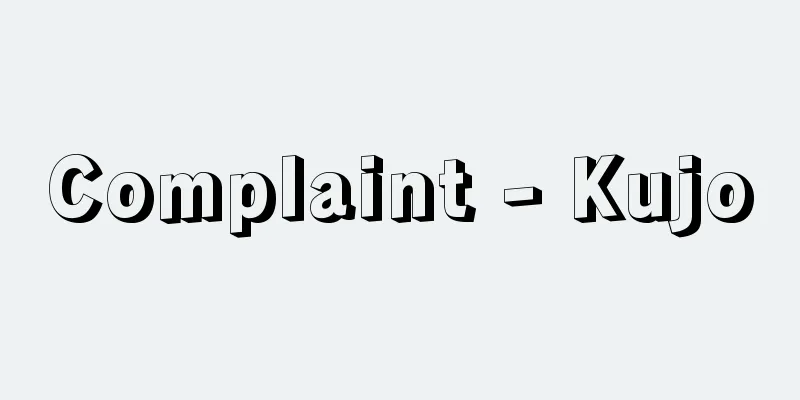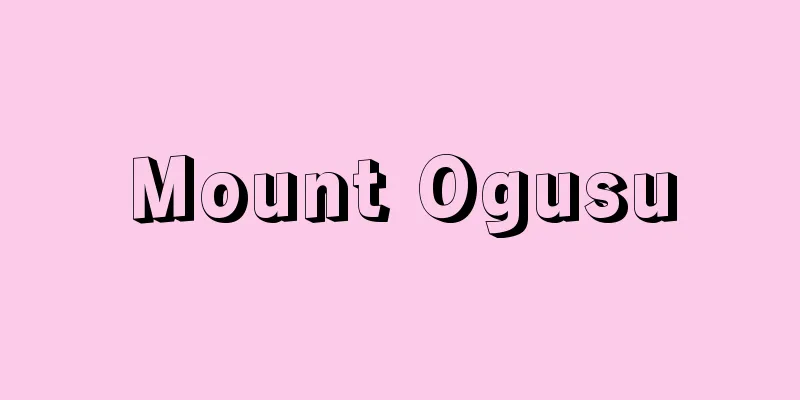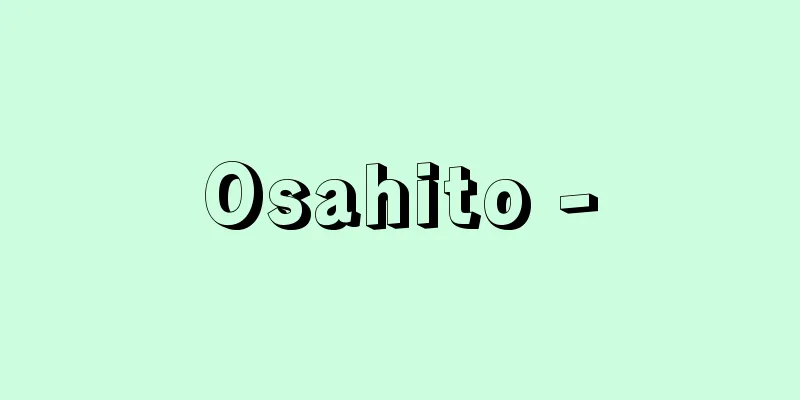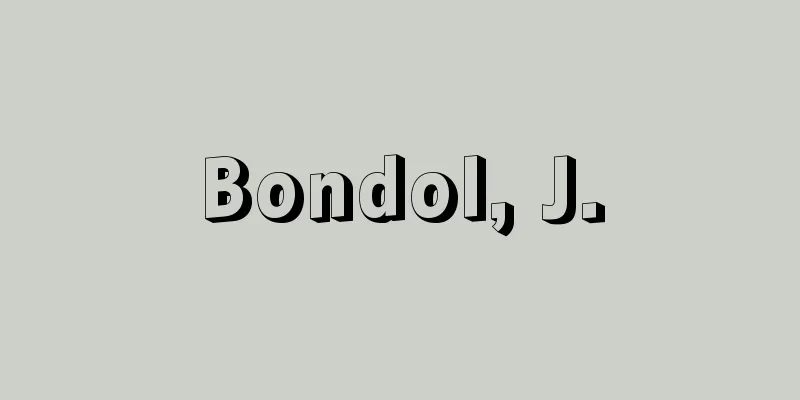Liberia - Liberia (English spelling)
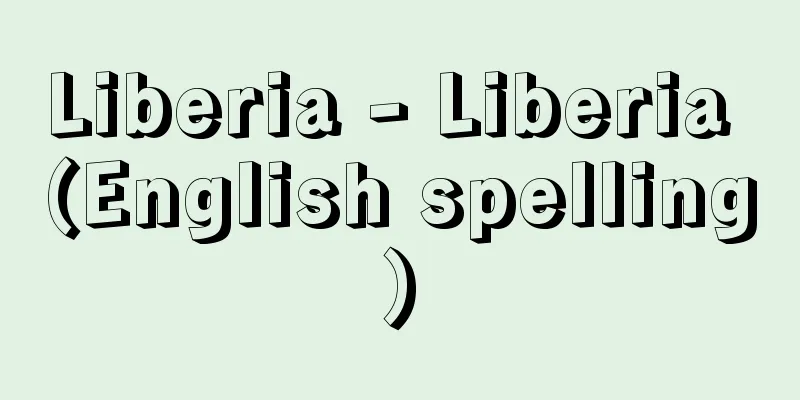
|
A country in southwestern West Africa. Its official name is the Republic of Liberia. It faces the Atlantic Ocean with a coastline of about 560 km to the southwest, and borders Sierra Leone to the northwest, Guinea to the north, and Côte d'Ivoire to the east. It is known as the first republic in Africa, founded in July 1847 by freed slaves of African descent who emigrated from America. It has an area of 111,000 square kilometers and a population of 2.91 million (estimated as of 2000). The capital is Monrovia. [Hiromitsu Nakamura] NatureThe flat area along the Atlantic coast is 16 to 80 kilometers wide and is connected by mangrove swamps, atolls, and inlets, while inland there are plateaus such as the Nimba Mountains and the Utibi Mountains. Six major rivers, including the St. Paul River, which flows into the Atlantic Ocean at a right angle, cross the country. Most of the country is covered by tropical rainforest, but the northern part is savanna. The climate is tropical and humid, with a small annual range and an average annual temperature of around 27°C. Annual precipitation reaches 5,100 mm along the coast and 2,000 mm inland. The rainy season (late April to mid-November) is long, and during the dry season (December to March), the harmattan (a wind containing sand dust from the Sahara Desert) blows, making it cooler. [Hiromitsu Nakamura] historyThe indigenous people of Liberia are believed to have migrated from the savannah regions of the north and east between the 12th and 16th centuries. In 1461, the Portuguese Peter da Sintra arrived, and since then, pepper and other commodities were traded between the indigenous people and Europeans along the coast, and this area was called the Pepper Coast. In 1822, the American Colonization Society, established by an American Christian organization, settled freed African slaves in the area of present-day Monrovia. They declared independence and established a constitution on July 26, 1847, and by 1865, about 20,000 freed slaves had entered the country. The settlers cultivated sugarcane, tobacco, cotton, fruit trees, vegetables, and other crops, and coffee and sugar plantations developed, with Liberian coffee in particular being known for its high quality. However, in the 1870s, coffee and sugar were lost to competition from Brazil and Cuba, the national finances collapsed, debts accumulated, and the country's economy stagnated for about 50 years. In 1926, the American company Firestone built the world's largest rubber plantation, and rubber exports began in 1934. During World War II, an American air force base was built, and the port facilities in Monrovia were renovated by the American military. Furthermore, the open door policy (introduction of foreign capital) and national unification policy (reducing the gap between settler residents and the indigenous people living in the interior) of W. Tubman, who became president in 1944, stimulated Liberia's economic development. In 1971, Tubman died and Vice President R. Tolbert became president. Tolbert continued Tubman's policies, and was elected unopposed in the 1975 presidential election. However, by the end of the 1970s, the economy had deteriorated due to rising oil prices and falling prices of export products such as steel and rubber. In March 1979, riots broke out in the capital Monrovia in opposition to an increase in the consumer price of rice, which was intended to increase domestic rice production, resulting in over 100 deaths. In September of the same year, the Progressive People's Party (PPP) was formed, and in March 1980, the PPP called for a nationwide strike. The Tolbert government arrested PPP leader G. B. Mathews and others, but on April 12, just before the trial of Mathews and others, a coup was carried out by Sergeant Samuel Doe, a native Kraan from the interior. Tolbert was killed, the constitution and parliament were suspended, and the National Salvation Council (PRC) began military rule, attempting to wipe out the previous American ruling class. In December 1982, PRC Chairman Do promised to restore civilian rule, established a Constitutional Committee, and in a referendum in July 1984 drafted a new constitution, allowed the formation of new political parties, and dissolved the PRC. [Hiromitsu Nakamura] PoliticsThe Constitution enacted in 1984, like the 1847 Constitution, was modeled on the American Constitution, and adopted a bicameral system with a 26-seat Senate and 64-seat House of Representatives, clearly separating legislative and executive powers. In the 1985 election, the National Democratic Party (NDPL), led by party leader Doe, won 22 of the 26 senate seats and 51 of the 64 House of Representatives seats. In the presidential election, candidate Doe won with 50.9% of the vote. One month after this election, in November, a coup attempt was carried out by Brigadier General Kiwompa, who was in exile in the United States, resulting in the deaths of 600 people. Kiwompa was killed and opposition leaders were arrested. In January 1986, Doe was inaugurated as president, restoring civilian rule to the country. However, domestic politics remained unstable, and in March 1988, Gabriel Kpore, leader of the opposition United Party of Liberia (UP), was arrested and imprisoned for plotting to overthrow the government. In December 1989, an armed uprising against Doe and the Krahn rule was started by the National Patriotic Front of Liberia (NPFL) led by Charles Taylor in Nimba County in the northeast. By the first half of 1990, the NPFL had taken control of most of Liberia, except for the capital, Monrovia. In Monrovia, the Independent Patriotic Front of Liberia (INPFL) led by Prince Johnson, which had split off from the NPFL, was in conflict with Doe's government forces. In response to this state of chaos, the Economic Community of West African States (ECOWAS) decided to intervene in August. The ECOWAS Observer Force (ECOMOG) was dispatched to mediate between the various armed factions. Doe was killed by the INPFL on September 11. On November 22 of the same year, Amos Sawyer was inaugurated as interim president with the support of ECOWAS. Negotiations with the armed factions to end the civil war were conducted through ECOWAS and neighboring West African countries, as well as the Organization of African Unity (OAU), and peace agreements were reached in Yamoussoukro, Cotonou, Geneva, and other places. However, it took a long time for fighting to stop completely and for disarmament to proceed. In June 1991, supporters of former President Doe reorganized and organized the armed group as the United Democratic Liberation Front of Liberia (ULIMO). In July 1993, a peace conference was held in Geneva under the auspices of the United Nations and ECOWAS, and a comprehensive peace agreement was signed on July 5 in Cotonou, Benin. In September, the UN Security Council decided to send the United Nations Observer Mission in Liberia (UNOMIL). This agreement also authorized the reorganization of the Transitional National Unity Government (IGNU), which had been in place since September 1990, and the Liberian Transitional National Council (LNTG) was established in May 1994. In May 1995, this was reorganized into the Liberian Transitional National Council (LNTG) led by Taylor (NPFL), with George Boley (LPC, Liberia Peace Council, Krahn faction) and Abraham Cromer (ULIMO-M, Liberia United Democratic Liberation Front, Mandingo faction, Islam) among others participating as vice-chairmen. In April 1996, the NPFL and ULIMO-K (United Democratic Liberation Front of Liberia - Krahn faction) clashed in Monrovia, and fierce fighting continued until the end of May. The United States dispatched ships to protect Americans living in Liberia and conducted a rescue operation. At the ECOWAS Liberia Conference held in Abuja in August, an agreement was reached on a ceasefire between the armed factions, and a schedule was finalized for the transition to civilian rule, including disarmament, dissolution of factions, and presidential and parliamentary elections. In the general elections held on July 19, 1997, the National Patriotic Party (NPP, formerly the NPFL faction) won 21 of the 26 senate seats and 49 of the 64 lower house seats. In the presidential election, party leader Taylor won 66% of the votes, a large margin over Ellen Johnson Sirleaf (Liberia Unity Party, UP, 15.9%). Taylor became president on August 2 after a transition from about eight years of civil war to civilian rule. In 1999, the civil war flared up again. In February 2002, a national emergency was declared (lifted in September) due to an uprising by the rebel group, the United Liberian Reconciliation Union (LURD). In June 2003, fighting between government forces and rebel forces near the capital, Monrovia, escalated, and LURD forced President Taylor to resign. In September, Taylor resigned as president and fled to Nigeria, and Vice President Moses Buller became president. In the same month, Buller's government and two rebel groups (LURD and MODEL) signed a peace agreement. An interim government incorporating the two rebel groups was created and it was decided that elections would be held in 2005. In October 2003, an interim government was formed, with Jude Bryant as chairman, and Buller handed over power to the government. In the first presidential election since the civil war, held in November 2005, a runoff election was held between Sirleaf and former professional football player George Weah, and Sirleaf won, becoming Africa's first female president. In terms of diplomacy, the country has had strong ties with the United States since its founding, and has maintained a pro-Western and neutral policy even after World War II. During the Doe military administration, there was temporary exchange with the socialist bloc, but diplomatic relations with Israel, which had been severed in 1973, were restored in 1983, and the country is once again strengthening its pro-Western tendency. In terms of diplomatic relations with neighboring African countries, former President Tubman, as a central leader of the moderate faction of the Pan-Africanist movement, contributed to the formation of the OAU (the OAU was reorganized as the African Union in July 2002). In 1973, the country formed the Mano River Union (MRU) with neighboring Sierra Leone with the aim of creating a customs union and a common market (Guinea joined in 1980), and in 1975 it participated in the founding of ECOWAS. It is also noteworthy that since the civil war that began in late 1989, the influence of ECOWAS, the OAU, and the United Nations in Liberia has grown, and there is a possibility of conflict with neighboring countries, particularly Sierra Leone and Côte d'Ivoire, over refugee movements, smuggling, and anti-government activity. The military is volunteer-only, with 5,300 in the Army and 450 in the Navy, for a total of 5,750 troops. Defense spending in 2001 was estimated at $15 million. [Hiromitsu Nakamura] Economy and IndustryThe economy is dependent on small-scale subsistence agriculture, which the majority of the population engages in, and on the export of primary products such as iron ore and rubber. From 1926, when the American Firestone Company developed vast rubber plantations, until the late 1950s, rubber exports were the largest pillar of the Liberian economy. In the 1950s, development of iron mines began, and in 1961, iron ore exports surpassed rubber exports, and in the 1980s they accounted for 70% of total exports. Liberia's largest iron mine is the Nimba mine, which is estimated to contain 1 to 2.3 billion tons of high-grade iron ore. Located in Nimba County, bordering Guinea, it has been developed since 1963 by the Liberian American Swedish Mining Company (LAMCO). LAMCO also built a 274-kilometer railway line dedicated to transporting ore between the mine and the export port of Buchanan. In the 1980s, the global economic downturn caused LAMCO's production to fall sharply from 10 million tons in 1981 to 2 million tons. Diamonds were discovered in the lower Lofer River area in 1957, and exports rose to $49.4 million (812,000 carats) in 1973, but fell to just $8.8 million in 1988, accounting for 2 percent of total exports. The most important agricultural export is rubber, with coffee and cocoa also being exported. Firestone's large plantations at Harbel and Kabala, and Goodrich's plantations were the main producers of rubber, but they lost out to producers in Southeast Asia (Malaysia). In 1983, Firestone sold its Liberian shares to Bridgestone (Japan), and in the same year Goodrich sold its plantations to the Malaysian Guthrie Group. Meanwhile, many small Liberian producers stopped rubber production. According to estimates by the International Rubber Study Group, rubber production fell from 106,000 tons in 1989 to 13,000 tons in 1995. Coffee and cocoa are mainly produced by small farmers. Coffee, Robusta, was cultivated in the north and produced 8,000 to 10,000 tons before the civil war, half of which was exported, but according to estimates by the Food and Agriculture Organization of the United Nations, production had fallen to 300 tons in 1994. Cocoa was introduced to Maryland, but production dropped sharply during the civil war. In terms of trade, in 1989, just before the civil war, Germany accounted for 32.2% of exports, the United States 19.3%, and Italy 15.7%, while the United States 32.2%, Germany 9.7%, and Japan 8.4%. Developed countries in the West and Japan accounted for an overwhelming proportion, and trade with neighboring African countries was extremely small. Looking at trade items, the top exports were iron ore 55.1%, rubber 28.0%, and lumber 8.4%, while the top imports were machinery and transport equipment 31.1%, petroleum and related products 22.7%, light industrial products 16.4%, and food 16.4%. Liberia was the world's largest ship-owning nation until 1992 thanks to its Flag of Convenience system, but in 1993 it fell to second place after Panama. Its registered tonnage in 1995 was 92,291,000 tons (12.2%), second only to Panama's 98,409,000 tons (14.6%). However, this only indicates a nominal number of registered ships, and in reality most of Liberia's ships are owned by Western shipowners, such as Americans and Greeks. Revenues from this Flag of Convenience system account for 10% of the national income. The National Bank of Liberia issues Liberian dollar banknotes as the central bank. The Liberian dollar was exchangeable at par with the US dollar, but the excessive issuance of new 5 Liberian dollar coins between 1982 and 1989 led to the hoarding of US dollars, which was exacerbated by the civil war. US dollar notes were exchanged at a rate of more than 30 times that of Liberian dollars, and during the fighting in April-May 1996, the ratio reached 72:1. The new 5 Liberian dollar notes issued in January 1992 (commonly known as Liberty Dollars) were considered illegal by the NPFL, but after the establishment of the Transitional National Council (TCS) in March 1994, both the old and new notes were made legal. [Hiromitsu Nakamura] Society and CultureThe population is made up of indigenous Sudanese blacks from about 26 tribes, making up 96% of the population. In terms of language, they are divided into Mande (northern and western), Kru (eastern and southeastern), and Mer (northwestern). Americo-Liberians, descendants of freed slaves who immigrated from America at the time of the country's founding, make up only about 3% of the population, but they are the dominant force. Foreigners, mainly Lebanese immigrants, also have a strong influence and mainly control commerce and industry. The official language is English, but the various tribal languages are also used daily. In terms of religion, it is estimated (1994) that 31% are Muslim, 10% are Christian (mostly Americo-Liberal) and 59% belong to tribal religions. Up until the Second World War, approximately 80% of public education was provided by missionaries and other organizations. Currently, nine years of education is compulsory from age 7 to 16, with an estimated primary school attendance rate of 35% and adult literacy rate of 40% (50% for men, 29% for women) (1990). As for higher education institutions, the University of Liberia, founded in 1862 as Liberia College and renamed in 1951, is located in Monrovia. Newspapers include the Daily Observer (daily) and the Sunday Express (weekly), both of which are in English. There is only one television station, the government-run ELTV (Liberia Broadcasting System), but radio is broadcast by the government-run ELBC as well as LAMCO (Nimba), which also broadcasts in English and Liberian languages in cooperation with ELBC. In 1985, before the civil war, there was one doctor for every 9,687 inhabitants and one hospital bed for every 653 inhabitants, both above the average for sub-Saharan Africa. Life expectancy was estimated at 54 years for men and 57 years for women in the 1990-1995 period, up from 50 years for men and 53 years for women in the 1980-1985 period. The civil war that began in December 1989 caused about one million refugees to flee to neighboring countries in 1990. The number of refugees fluctuated with the state of the fighting, but in January 1995, the United Nations High Commissioner for Refugees (UNCHR) reported that 471,000 Liberian refugees had fled to Guinea, 360,000 to Côte d'Ivoire, 16,000 to Sierra Leone, 14,000 to Ghana, and 4,000 to Nigeria, while about 120,000 Sierra Leonean refugees had flowed into Liberia. The fighting in the vicinity of Monrombia in April and May 1996 further increased the number of refugees, and it is estimated that 150,000 to 200,000 civilians were killed. [Hiromitsu Nakamura] Relations with JapanDiplomatic relations with Japan were established in May 1962, and the Liberian Embassy in Japan was established in February 1969, followed by the Japanese Embassy in Liberia in January 1973 (temporarily closed in 1990 due to the intensification of the civil war). In addition, it was decided in August 1978 to dispatch Japan Overseas Cooperation Volunteers. Economic cooperation included the purchase of road construction machinery at cost (6.85 billion yen), free food aid, and the establishment of Monrovia Hospital (7.537 billion yen) until 1993, and technical cooperation included the dispatch of 13 trainees, 29 experts, 87 survey teams, and 50 cooperation volunteers between 1958 and 1985. Trade with Japan saw exports of 9 million yen in machinery and other items and imports of 78.679 billion yen (2000), resulting in a large import surplus. This is due to Liberia's flag of convenience system, and approximately 80% of imports are by ship. [Hiromitsu Nakamura] [References] | | | | | | | | | [Additional Information] |"> Flag of Liberia ©Shogakukan Illustration/Shogakukan Creative "> Liberia Location Map Source: Shogakukan Encyclopedia Nipponica About Encyclopedia Nipponica Information | Legend |
|
西アフリカ南西部の国。正称はリベリア共和国Republic of Liberia。南西は約560キロメートルの海岸線で大西洋に面し、北西はシエラレオネ、北はギニア、東はコートジボワールに接する。1847年7月、アメリカから移住したアフリカ系解放奴隷が建設した、アフリカ最初の共和国として知られる。面積11万1000平方キロメートル、人口291万(2000推計)。首都はモンロビア。 [中村弘光] 自然大西洋沿岸の平坦(へいたん)地帯は16~80キロメートルの幅で、マングローブ沼地、環礁、入り江がつながり、その内陸部にニンバ山地、ウティビ山地などの高原地帯がある。大西洋に直角に流入するセント・ポール川など六大河川が国土を横断している。大部分が熱帯雨林地帯であるが、北部はサバンナ地帯である。気候は熱帯性で湿度が高く、年較差は小さく年平均気温は27℃前後である。年降水量は沿岸部では5100ミリメートル、内陸部では2000ミリメートルに達し、雨期(4月下旬~11月中旬)が長く、乾期(12月~3月)にはハルマッタン(サハラ砂漠の砂塵(さじん)を含む風)が吹き、涼しくなる。 [中村弘光] 歴史リベリアの先住民は、12~16世紀に北方および東方のサバンナ地帯から移動してきた人々と推定されている。1461年にポルトガル人のペトロ・ダ・シントラが来訪し、以後沿岸地帯で先住民とヨーロッパ人との間でコショウなどの取引が行われ、この地域は胡椒(こしょう)海岸とよばれた。1822年にアメリカのキリスト教団体が設立したアメリカ植民協会が、アフリカ系解放奴隷を現在のモンロビアの地域に入植させた。彼らは1847年7月26日に独立を宣言して憲法を制定、1865年までに約2万人の解放奴隷が入国した。入植者によってサトウキビ、タバコ、綿花、果樹類、野菜などが栽培され、コーヒーおよび砂糖のプランテーションが発達し、とくにリベリア・コーヒーは品質のよさで知られた。しかし、1870年代にコーヒー、砂糖はブラジルやキューバとの競争に敗れ、国家財政は破綻(はたん)し債務が累積され、国の経済は約50年間停滞した。 1926年にアメリカのファイアストン社が世界最大のゴム・プランテーションを建設し、1934年からゴムの輸出が開始された。第二次世界大戦中にはアメリカの空軍基地が建設され、モンロビアの港湾施設がアメリカ軍によって改築された。また、1944年大統領に就任したW・タブマンによる門戸開放政策(外資の導入)や国内統一化政策(入植者系住民と内陸部に住む先住民との格差の縮小)は、リベリアの経済開発に刺激を与えた。1971年タブマンが死去し副大統領のR・トルバートが大統領に就任した。トルバートはタブマンの政策を継承し、1975年の大統領選挙では無競争で選出された。 しかし1970年代末には、石油価格の高騰および鉄、ゴムなど輸出産品価格の下落によって経済状況が悪化した。1979年3月、国内産米の増産を意図した消費者米価の引き上げに反対して、首都モンロビアで暴動が起こり死者は100人を超えた。同年9月には進歩人民党(PPP)が結成され、1980年3月にPPPは全国ストライキを呼びかけた。トルバート政府はPPPの指導者G・B・マシューズらを逮捕したが、マシューズらの裁判の直前の4月12日、内陸部の先住民クラーン出身のサミュエル・ドウ曹長によるクーデターが起こった。トルバートは殺害され、憲法、国会は停止され、国家救済評議会(PRC)による軍政が始まり、従来のアメリカ系支配層の一掃が図られた。 1982年12月、PRC議長ドウは民政復帰を約束し憲法委員会を設置、1984年7月の国民投票で新憲法を制定し、新政党の結成を認めるとともにPRCを解散した。 [中村弘光] 政治1984年制定された憲法は、1847年憲法と同様にアメリカ憲法をモデルとし、上院(26議席)、下院(64議席)の二院制をとり、立法権と行政権の分離を明確にしている。1985年の選挙では、ドウ党首の率いる国家民主党(NDPL)が、上院26議席のうち22議席、下院64議席のうち51議席を獲得。大統領選挙では、ドウ候補が50.9%の投票を獲得して当選した。この選挙の1か月後の11月には、アメリカに亡命していたキウォンパ准将によるクーデター未遂事件が起こり、600人に及ぶ死者を出した。キウォンパは殺害され、野党指導者は拘束された。 1986年1月ドウが大統領に就任し、民政に復帰した。しかし国内政治は不安定な状況が続き、1988年3月には、野党リベリア統一党(UP)党首ガブリエル・クポレが政府転覆謀議のかどで拘束、投獄された。 1989年12月ドウならびにクラーン人支配に反対する武装蜂起が、北東部ニンバ郡において、チャールズ・テーラーを指導者とするリベリア国民愛国戦線(NPFL)によって開始された。NPFLは、1990年前半には首都モンロビアを除くリベリアの大半の地域を支配下に収めた。モンロビアではNPFLから分かれたプリンス・ジョンソンのリベリア独立愛国戦線(INPFL)とドウの政府軍とが対立していた。こうした混乱状態に際し、8月には西アフリカ諸国経済共同体(ECOWAS)の介入が決定。ECOWAS監視軍(ECOMOG)が派遣され、諸武装派間の調整にあたった。ドウは9月11日に、INPFLによって殺害された。同年11月22日ECOWASの支持を得て、アモス・ソーヤーが暫定大統領に就任した。 内戦終結への武装各派との交渉は、ECOWASおよび近隣西アフリカ諸国、あるいはアフリカ統一機構(OAU)などを通じて行われ、ヤムスクロ、コトヌ、ジュネーブなど各地で和平協定が選ばれた。しかし完全に戦闘が停止し、武装解除が進められるには、長い時間がかけられた。また、前大統領ドウ支持派は、1991年6月武装グループをリベリア民主統一解放戦線(ULIMO)として再編、組織した。 1993年7月、ジュネーブにおいて国連・ECOWAS支援の下で和平会議が開催され、7月5日ベナンのコトヌで包括的和平協定が締結された。9月には、国連安全保障理事会が国連リベリア監視団(UNOMIL)の派遣を決定した。またこの協定で1990年9月に始まった暫定国家統一政府(IGNU)を再編することが認められ、1994年5月にリベリア暫定国家評議会(LNTG)が発足した。これが1995年5月には、テーラー(NPFL)が主導する暫定国家評議会(LNTG)に再編成され、ジョージ・ボーリー(LPC、リベリア平和協議会・クラーン派)、アブラハム・クロマー(ULIMO―M、リベリア民主統一解放戦線―マンディンゴ派、イスラーム)らも副議長として参加した。 1996年4月、モンロビア市内においてNPFLとULIMO―K(リベリア民主統一解放戦線―クラーン派)とが衝突し、激しい戦闘が5月末まで続いた。アメリカは在留アメリカ人保護のため艦船を派遣し、救出作戦を行った。8月に、アブジャで開かれたECOWASリベリア問題会議において、武装各派間の停戦についての合意ならびに武装解除、派閥解体、大統領選挙、議会選挙などの民政への移行までの日程が確定された。 1997年7月19日の総選挙において、国民愛国党(NPP、旧NPFL派)が上院26議席のうち21議席、下院64議席のうち49議席を占めた。大統領選挙では党首テーラーが約66%の得票で、エレン・ジョンソン・サーリーフ(リベリア統一党、UP、15.9%)に大差をつけて勝利した。テーラーは、約8年間続いた内戦から民政への移行過程を経て、8月2日に大統領に就任した。1999年、内戦が再燃。2002年2月反政府勢力のリベリア民主和解連合(LURD)の蜂起により、国家非常事態宣言を発令(9月解除)。2003年6月には首都モンロビア近郊での政府軍と反政府軍による戦いが劇化、LURDは大統領テーラーの辞任を迫った。9月テーラーが大統領を辞任しナイジェリアに亡命、副大統領モーゼス・ブラーが大統領に昇格した。同月、ブラー政権と反政府組織2派(LURD、リベリア民主運動=MODEL)は和平協定に調印。反政府組織2派を取り込んだ暫定政府をつくり、2005年に選挙を実施することを決めた。2003年10月暫定政府が発足、議長にジュード・ブライアントが就任し、ブラーは政権を譲渡した。2005年11月に行われた内戦後初の大統領選挙では、サーリーフと元プロサッカー選手ジョージ・ウェアによる決選投票が行われサーリーフが当選。アフリカ初の女性大統領が誕生した。 外交は、建国以来アメリカとの関係が強く、第二次世界大戦後も親欧米的中立政策を堅持してきた。ドウ軍政期には一時的に社会主義圏との交流もみられたが、1973年に国交を断絶したイスラエルと1983年に復交、ふたたび親欧米的傾向を強めている。近隣アフリカ諸国との外交関係では、元大統領タブマンは汎(はん)アフリカ主義運動の穏健派の中心的指導者として、OAUの結成に寄与した(OAUは2002年7月アフリカ連合に改組)。1973年に隣国シエラレオネとともに関税同盟、共同市場を目的としたマノ川同盟(MRU)を結成し(1980年にギニアも加盟)、1975年にはECOWASの創設にも参加している。 また1989年末からの内戦以降、ECOWAS、OAU、ならびに国際連合のリベリアに及ぼす影響力が大きくなっていること、近隣諸国とくにシエラレオネ、コートジボワールとの間に、難民移動、密輸、反政府活動をめぐっての紛争の可能性があることが注目される。 軍隊は志願兵制で、陸軍5300人、海軍450人、総兵力5750人。2001年の国防費は推定1500万ドル。 [中村弘光] 経済・産業経済は、人口の大半が従事する小規模自給農業と、鉄鉱石、ゴムなどの第一次産品の輸出に依存している。1926年にアメリカのファイアストン社が広大なゴム・プランテーションを開発して以来1950年代末まで、ゴムの輸出がリベリア経済の最大の支柱であった。1950年代に、鉄鉱山の開発が始まり、1961年には鉄鉱石の輸出額がゴムの輸出額を超え、1980年代には輸出総額の70%を占めた。リベリア最大の鉄鉱山は、高品位の鉄鉱石を10億ないし23億トン埋蔵すると推定されるニンバ鉱山である。ギニア国境に接したニンバ郡にあり、リベリア・アメリカ・スウェーデン鉱山会社(LAMCO)によって1963年から開発された。輸出港ブキャナンとの間にはLAMCOによって274キロメートルの鉱石運搬専用鉄道も建設された。1980年代には世界経済の不況によって、LAMCOの生産量は、1981年の1000万トンから200万トンへ急落した。ダイヤモンドはローファー川下流地域で1957年に発見され、輸出額は1973年に4940万ドル(81万2000カラット)に上昇したが、1988年には880万ドル、総輸出額の2%を占めるにとどまった。 おもな輸出用農産物はゴムがもっとも重要で、コーヒー、ココアも輸出されている。ゴムは、ファイアストン社のハーベル、カバラの大プランテーション、グッドリッチのプランテーションが主要な生産者であったが、東南アジア(マレーシア)の生産者との競争に敗れ、ファイアストン社は、1983年にそのリベリア系株式を、ブリヂストン社(日本)に譲渡し、同年、グッドリッチ社はマレーシア系ガスリーグループにプランテーションを譲渡した。一方、リベリア人小規模生産者の多くもゴム生産を停止した。国際ゴム研究グループの推定によれば、ゴム生産量は1989年の10万6000トンから1995年には1万3000トンに低下した。コーヒー、ココアはおもに小規模農業者によって生産されている。コーヒーはロブスタ種が北部で栽培され、内戦以前には8000ないし1万トンを生産、その半分が輸出されていたが、FAO(国連食糧農業機関)の推定によれば、1994年の生産量は300トンに低下した。ココアはメリーランド州に導入されたが、内戦期に、生産量は激減した。 貿易は、内戦直前の1989年に、輸出ではドイツ32.2%、アメリカ19.3%、イタリア15.7%、輸入ではアメリカ32.2%、ドイツ9.7%、日本8.4%であり、欧米日先進諸国が圧倒的な比重を占め、近隣アフリカ諸国との貿易額はきわめて少ない。貿易品目別にみると、輸出では鉄鉱石55.1%、ゴム28.0%、木材8.4%、輸入では機械・輸送機器31.1%、石油・同製品22.7%、軽工業品16.4%、食料16.4%がそれぞれ上位を占める。 リベリアは便宣置籍船制度によって1992年までは、世界最大の船舶保有国であったが、1993年にはパナマに次いで第2位となった。1995年登録の船舶登録トン数は9229万1000トン(12.2%)で、パナマの9840万9000トン(14.6%)に次いで世界第2位である。しかし、これは名目上の船舶登録数の多さを示すもので、実際のリベリア船のほとんどは、アメリカ人やギリシア人など欧米の船主の持ち船である。この便宣置籍船制度による収入は、歳入の10%を占めている。 中央銀行としてリベリア国立銀行National Bank of Liberiaがリベリア・ドル紙幣を発行している。リベリア・ドルとアメリカ・ドルとは平価で交換可能であったが、1982年から1989年に至る時期の新5リベリア・ドル貨幣の乱発により、アメリカ・ドルの退蔵化が始まり、内戦がさらにそれを悪化させた。アメリカ・ドル紙幣は、リベリア・ドル紙幣の30倍以上の交換比率となり、1996年4月から5月の戦闘時期には、72対1の比率になった。1992年1月に発行された新5リベリア・ドル紙幣(通称リバティー・ダラー)は、NPFLが非合法通貨とみなしていたが、1994年3月に暫定国家評議会(TCS)成立後、旧紙幣・新紙幣とも合法とされた。 [中村弘光] 社会・文化住民は、約26の部族からなる先住民のスーダン系黒人が96%を占める。言語系でみれば、マンデ系(北部・西部)、クル系(東部・南東部)、メル系(北西部)に分けられる。建国時にアメリカから入植した解放奴隷の子孫であるアメリコ・ライベリアンAmerico-Liberianは人口の約3%にすぎないが、支配勢力であった。また、レバノン系移住者を中心とする外国人の勢力も根強く、おもに商工業を支配している。公用語は英語であるが、各部族語も日常的に使用される。 宗教は31%がイスラム教、アメリコ・ライベリアンを中心に10%がキリスト教(ローマ・カトリック系がもっとも多い)、59%が部族宗教と推定(1994)されている。 教育は、第二次世界大戦時までは公的教育の約80%が伝導団などによるものであった。現在は、7~16歳までの9年間が義務教育で、初等教育(6年間)の就学率は35%、成人識字率は、40%(男性50%、女性29%)と推定されている(1990)。高等教育機関としては、1862年にリベリア・カレッジとして創設され、1951年に改称したリベリア大学がモンロビアにある。新聞は、『デイリー・オブザーバー』(日刊紙)、『サンデー・エキスプレス』(週刊紙)などいずれも英語紙である。テレビ放送は政府系のELTV(リベリア放送システム)1局のみであるが、ラジオ放送は政府系のELBCのほか、LAMCO放送局(ニンバ)もELBCと協力して英語、リベリア諸語による放送を行っている。 医療は、内戦前の1985年には、医師が住民9687人につき1人、病院ベッドが653人につき1台で、サハラ以南アフリカ諸国の平均を超えている。平均余命は、1990~1995年の推計で男54歳、女57歳とされ、1980~1985年推計の男50歳、女53歳より上昇している。 1989年12月に始まった内戦によって、1990年には約100万人の難民が近隣諸国に流出した。戦闘状態の変動に伴って、難民数は増減したが、1995年1月にはギニアに47万1000人、コートジボワールに36万人、シエラレオネに1万6000人、ガーナに1万4000人、ナイジェリアに4000人のリベリア難民が流出し、また、リベリア国内にはシエラレオネ難民が約12万人流入していると、国連難民高等弁務官(UNCHR)は報告している。1996年4~5月のモンロンビア近辺における戦闘は、難民数をさらに増加させ、15万ないし20万人の一般市民が死亡したと推定されている。 [中村弘光] 日本との関係1962年(昭和37)5月に日本との外交関係が樹立され、1969年2月に在日リベリア大使館が、1973年1月に在リベリア日本大使館(1990年内戦激化のため一時閉鎖)が設置された。また、1978年8月には青年海外協力隊の派遣が決定した。経済協力では、1993年まで有償で道路建設機械購入(68億5000万円)、無償で食糧援助、モンロビア病院設立(75億3700万円)などがあり、技術協力では1958~1985年に、研修員13名、専門家29名、調査団87団、協力隊50名が派遣されている。日本との貿易は輸出が機械類など900万円、輸入が786億7900万円(2000)で大幅な輸入超過となっている。これはリベリアの便宜置籍船制度によるもので、輸入額の約80%は船舶輸入である。 [中村弘光] [参照項目] | | | | | | | | | [補完資料] |"> リベリアの国旗 ©Shogakukan 作図/小学館クリエイティブ"> リベリア位置図 出典 小学館 日本大百科全書(ニッポニカ)日本大百科全書(ニッポニカ)について 情報 | 凡例 |
>>: Liberal Party - Liberal Party (English spelling)
Recommend
Portulaca oleracea - Portulaca oleracea
…As its name suggests, the stems are erect and ca...
Warabi-te-tou
This is an iron sword with a curved handle shaped...
Nonsan - Ronsan
A city located at the southeastern end of Chungch...
Kokubunji [city] - Kokubunji
A city in central Tokyo. It was incorporated as a ...
sacculina externa (English spelling) sacculinaexterna
...The cell mass passes through the needle and en...
Ohara Imajo - Ohara no Imajo
Years of birth: Dates of birth and death unknown. ...
amakihi
... Hawaiian honeycreepers prefer tropical rainfo...
Stoneworks of Asuka
There are about 20 strangely shaped stone structur...
Sumidera Shingyo - Sumidera Shingyo
These are the numerous copies of the Heart Sutra t...
Photosensitive resin plate - photosensitive resin plate
...(3) Photopolymerization type photosensitive re...
Fewkes, JW
...The newly developed recording technology at th...
Chromel
…It is an alloy whose main component is nickel (N...
Frigatebird (fighting ship bird) - Frigatebird
A general term for birds of the family Frigatebird...
Carolina parakeet (English spelling) Conuropsis carolinensis; Carolina parakeet
Order: Parrotfish, Family: Pycnonotidae. Total len...
NGL - NGL
《natural gas liquids 》Natural gasoline. Liquid hyd...


